高考必备语法主谓一致课件(33张)
图片预览

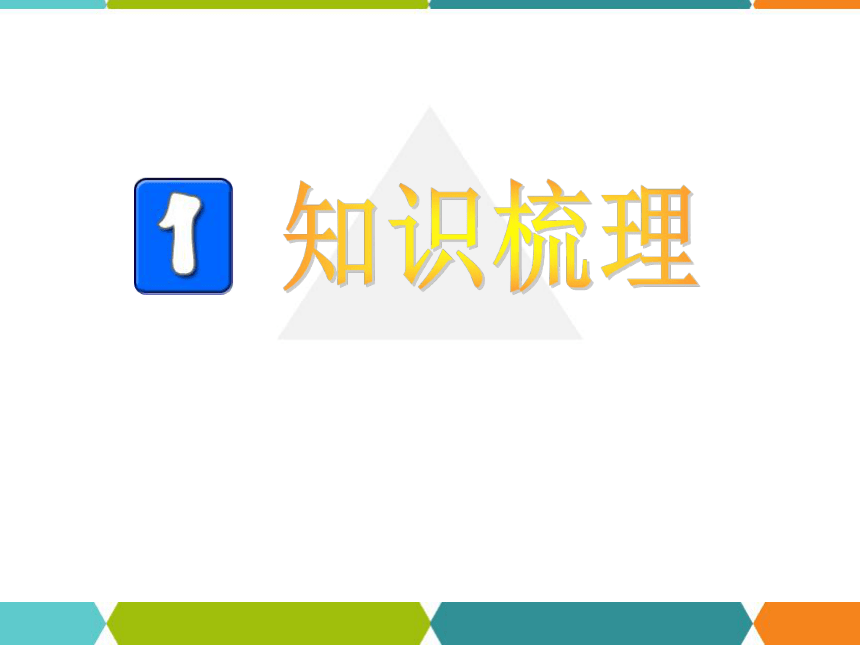
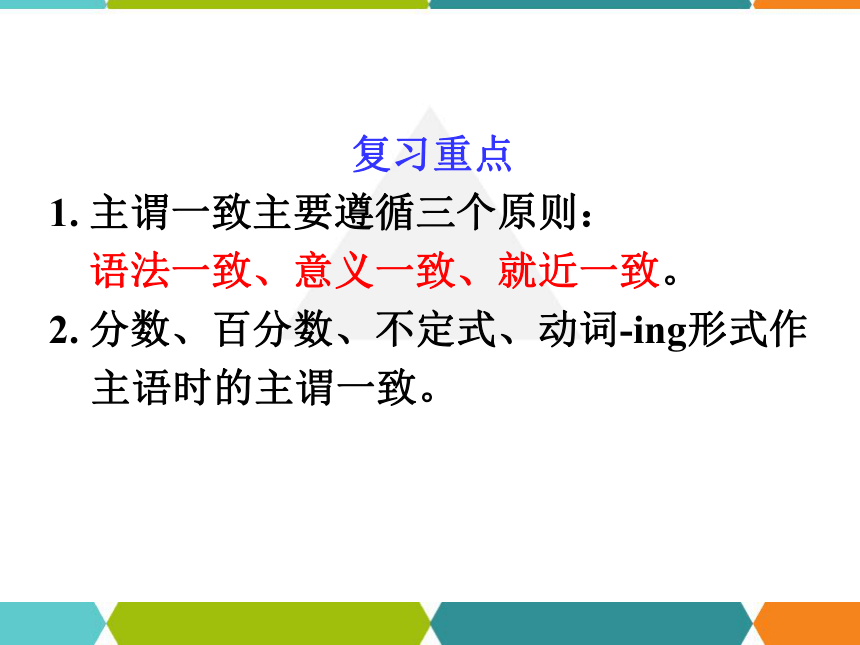



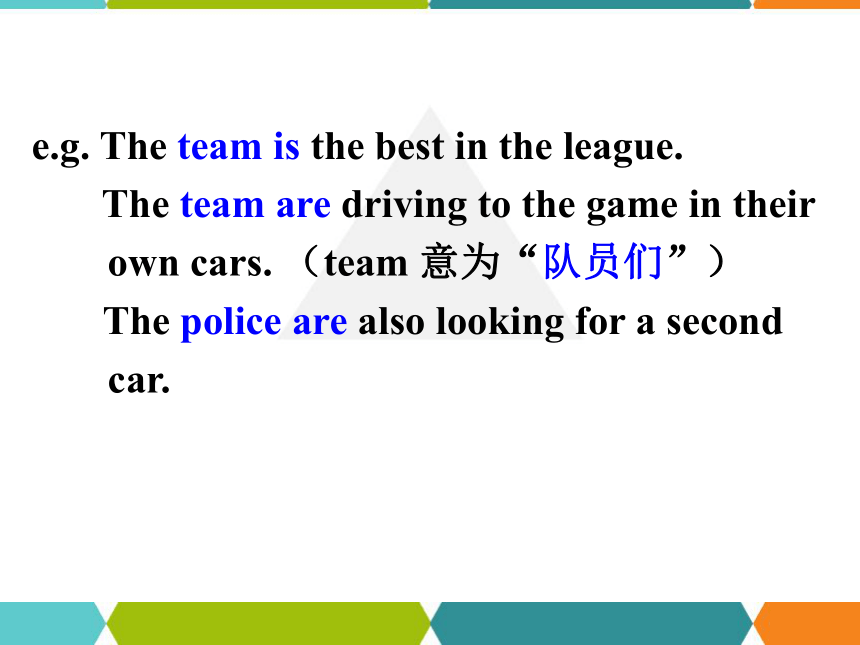
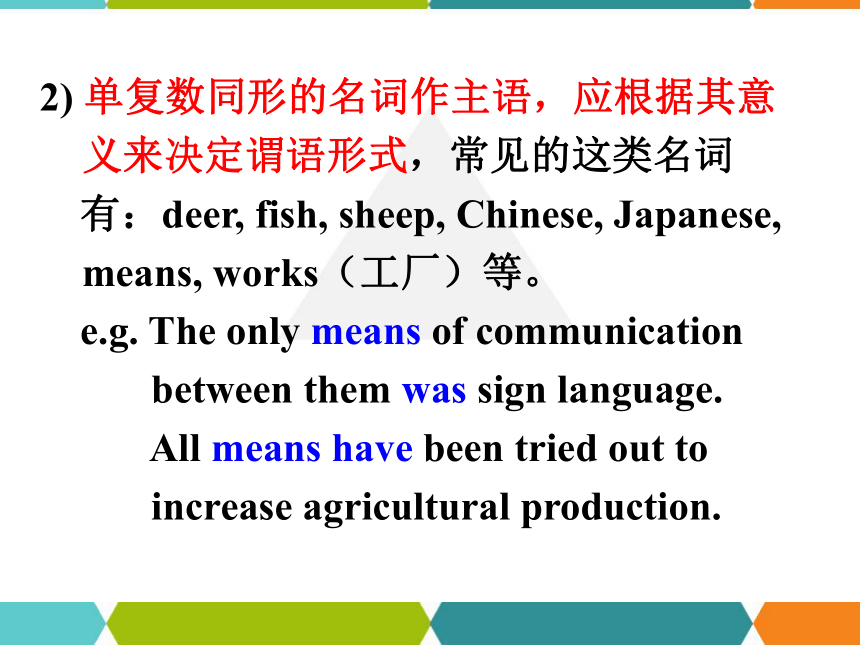
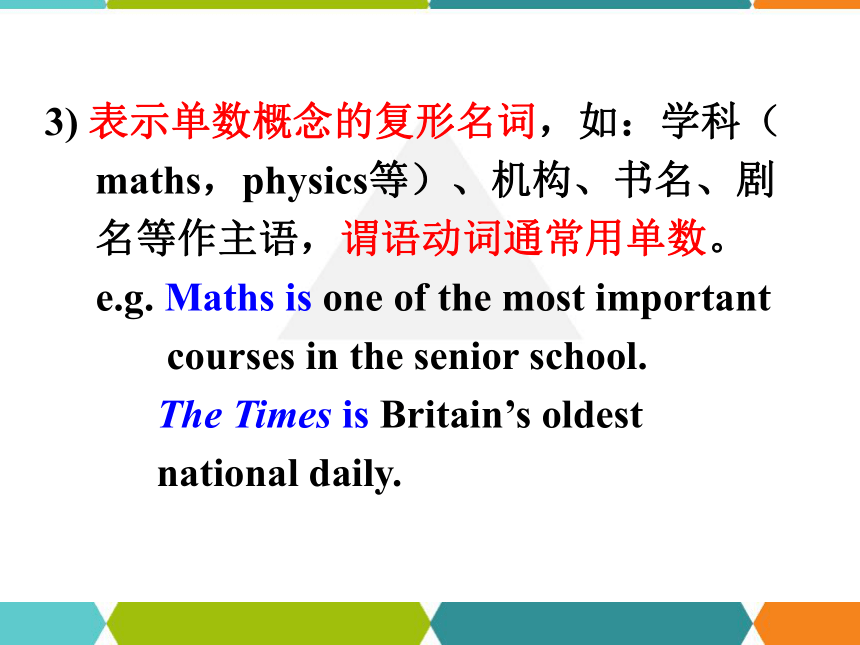
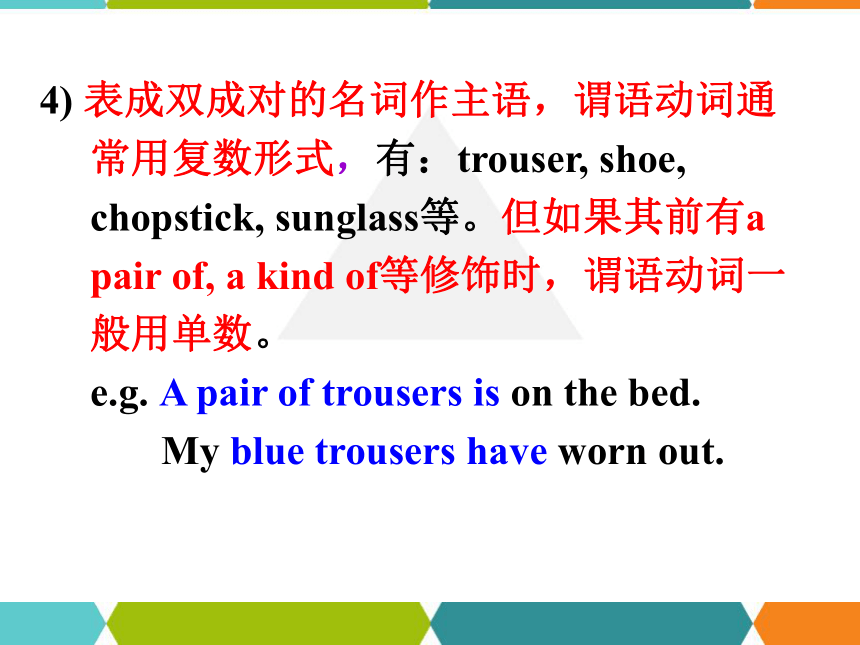
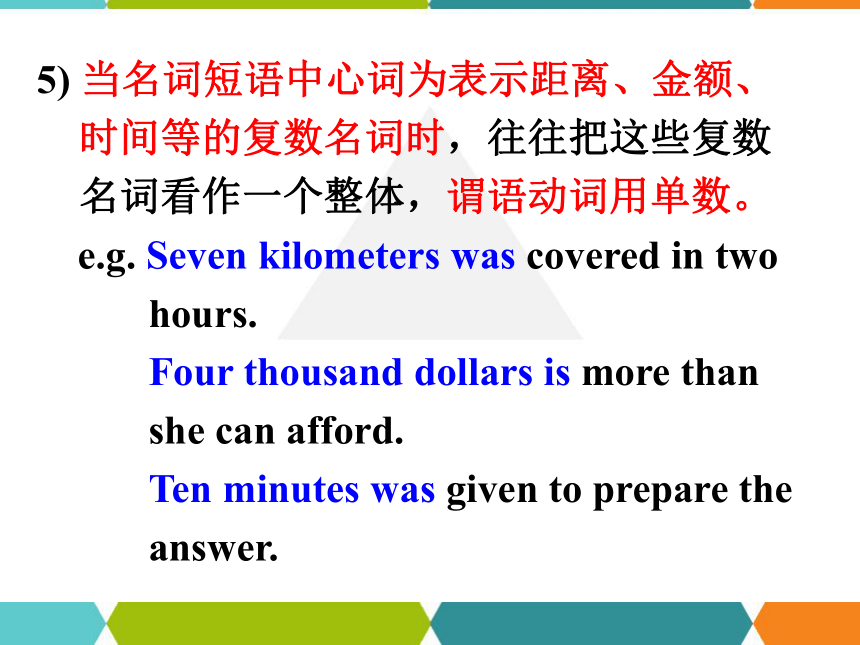
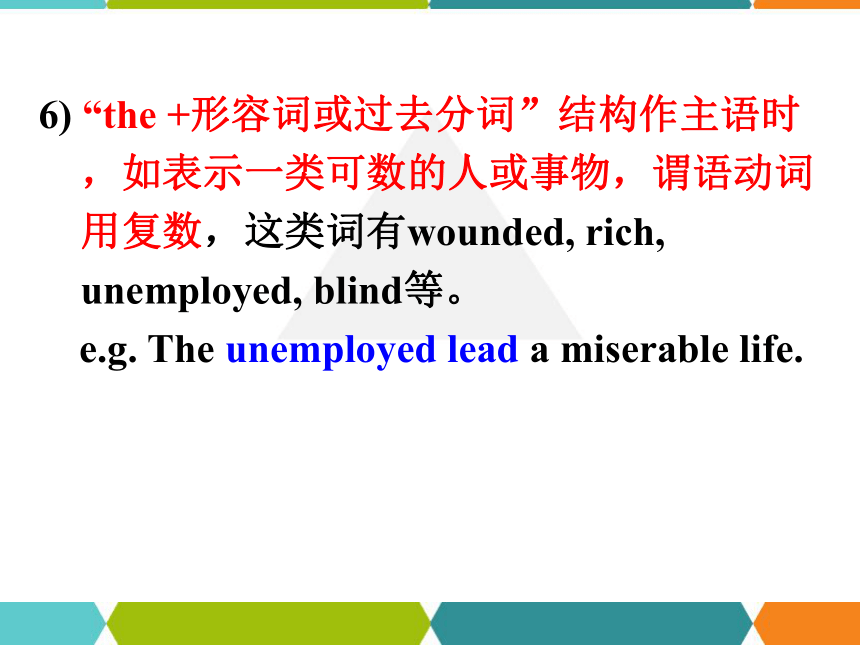
文档简介
复习重点
1. 主谓一致主要遵循三个原则:
语法一致、意义一致、就近一致。
2. 分数、百分数、不定式、动词-ing形式作主语时的主谓一致。
基础知识
一、主谓一致的原则
主谓一致是指主语和谓语在人称和数上保
持一致。一般遵循下列原则:
1. 语法一致原则:主语和谓语在人称和数上一致,即主语是单数形式,谓语动词也采用单数形式;主语是复数形式,谓语动词也采用复数形式。
2. 意义一致原则:谓语的单复数取决于主语的意义。有时主语形式上为单数,但意义上却是复数,那么谓语根据意义也用复数形式;有时主语形式上为复数,但意义上却是单数,那么谓语根据意义应用单数形式。
3. 就近一致原则:谓语动词的形式与邻近
的主语在人称和数上一致,如“There be
句型”即适用这一原则。
二、主谓一致的具体应用
1. 名词作主语
1) 集合名词作主语,如果表示整体概念,谓语动词用单数形式;如果强调个体,谓语动词用复数形式。常见的这类名词有:army, audience, class, family, team, crowd, staff, committee, enemy, government, population等。
有些集合名词如cattle, people, police等,通常看作复数,谓语动词必须用复数。
e.g. The team is the best in the league.
The team are driving to the game in their own cars. (team 意为“队员们”)
The police are also looking for a second car.
2) 单复数同形的名词作主语,应根据其意义来决定谓语形式,常见的这类名词
有:deer, fish, sheep, Chinese, Japanese, means, works(工厂)等。
e.g. The only means of communication
between them was sign language.
All means have been tried out to
increase agricultural production.
3) 表示单数概念的复形名词,如:学科(maths,physics等)、机构、书名、剧名等作主语,谓语动词通常用单数。
e.g. Maths is one of the most important
courses in the senior school.
The Times is Britain’s oldest
national daily.
4) 表成双成对的名词作主语,谓语动词通常用复数形式,有:trouser, shoe, chopstick, sunglass等。但如果其前有a pair of, a kind of等修饰时,谓语动词一般用单数。
e.g. A pair of trousers is on the bed.
My blue trousers have worn out.
5) 当名词短语中心词为表示距离、金额、时间等的复数名词时,往往把这些复数名词看作一个整体,谓语动词用单数。
e.g. Seven kilometers was covered in two
hours.
Four thousand dollars is more than
she can afford.
Ten minutes was given to prepare the
answer.
6) “the +形容词或过去分词”结构作主语时,如表示一类可数的人或事物,谓语动词用复数,这类词有wounded, rich, unemployed, blind等。
e.g. The unemployed lead a miserable life.
7) “more than one / many a +单数名词”作主语,谓语动词通常用单数形式;“more + 复数名词+than one ”作主语,谓语动词通常用复数形式。
e.g. There is more than one answer to
your question.
Many a critic is satisfied with the
play.
More boxes than one have been used
at the station.
8) “分数或百分数+ of + 名词”构成的短语作主语时,谓语动词的单复数取决于of 后名词的数。
e.g. Only one third of the work was done
yesterday.
Three fourths of the students come to
school on time.
2. 代词作主语
1) 由代词each, every one, no one, either, neither, another以及合成代词something, anything, nothing, everything, somebody, anybody, nobody, everybody, someone, anyone, everyone作主语时,谓语动词均用单数。
e.g. Two boys entered. Each was carrying
a suitcase.
Anyone who is over sixteen is allowed in.
2) 关系代词who, that, which 等在定语从句中作主语时,谓语动词的数应与先行词的数一致。
e.g. David is one of those people who have
trouble making up their minds.(先行
词是people )
He is the only one of the students who
was late this morning.(当one 前有
the only 时,先行词是one)
3) all, most, none, some 等作主语时,谓语动词的形式要根据它们所代替的内容来定。
e.g. All who have studied this question
have come to the same conclusion.
None is more qualified for the task
than he.
3. 由连接词连接的名词或代词作主语
1) 用and或both ... and ... 连接并列主语,如果意义为复数,谓语动词通常用复数。但由and连接的并列主语如果指的是同一个人、同一事物或同一概念,谓语动词则用单数形式,这时and后面的可数名词不带冠词。
e.g. Both the secretary and the manager have agreed to be present.
Law and order means different things to people with different political opinions.
There is a watch and chain on the table. (watch and chain 带链的表)
2) 当主语后跟有说明主语的修饰语,如用with, as well as, along with, rather than, together with, including, in addition to与修饰语连接时,谓语动词的人称和数与主语保持一致。
e.g. The missing things, as well as the
bag, have been found and returned
to the owner.
3) 由or, either ... or ..., neither ... nor ..., not only ... but also ...等连接的名词或代词作主语时,谓语动词要与邻近的主语相一致。
e.g. Either his brother or his friends are
wrong.
Not only the students but also their
teacher goes to the exhibition.
4. 从句及非谓语动词作主语
1) 名词性从句作主语时,谓语动词通常用单数。但如果是两个或两个以上的从句由and连接表两个概念时,谓语动词用复数。另外,what从句作主语时,谓语动词的数由其表示的意义来决定。
e.g. Whether we go camping tomorrow depends on the weather.
What caused the snow slide and how many tourists are injured are still unknown.
What you want is a big bag.
You need not get any more stamps. What
we have are quite sufficient.
2) 动词-ing形式短语或不定式短语作主语时,谓语动词通常用单数。
e.g. Smoking / To smoke is a bad habit.
I. 选用am, is, are, was, were 填空。
1. As you can see, the instructions for downloading software from the Internet _______ confusing for many people.
2. The chief editor together with his editors _____ now discussing the new law about newspapers that ________ newly published last month.
are
is
was
3. There ________ still seventeen people ahead of me in the bank line, which drove me crazy.
4. I, who ________ your deskmate now, hope we can help each other with our studies.
5. It 's a good time to buy things, because everything on those shelves ______ on sale.
were
am
is
6. Nobody but doctors or nurses _____ allowed to enter the patient's room now.
7. Nowadays, rent and car insurance ________ my biggest expenses each month.
8. The manager and designer ________ to give some suggestions for the design of the new building tomorrow.
is
are
is
II. 用括号内动词的正确形式填空。
I used to think there 1. ________ (be) few tasks more difficult than picking out birthday presents for my friends. Since my husband and I don't have much extra money, expensive gifts are out, and the household goods on sale at K-Mart 2. ________ (be)
not the kinds of presents they'd enjoy getting.
were
are
But birthday shopping has become simpler since I decided that everybody really 3. ________ (like) toys. Children 's catalogs and novelty ( 新颖小巧物品的) shops 4. ________ (be) where I do my buying. Up to now, my favorites of the whole toy collection 5. ___________ (be) the rubber stamp sets. One of them 6. __________ (contain) funny pictures of parts of faces: eyes, ears, noses, and so on.
likes
are
have been
contains
With it, anyone 7. ________ (become) a cartoonist, creating silly faces to decorate all kinds of things. To another friend 8. _________ (send) flying saucers that fly into the air when you pull their strings. There 9. ________ (be) now saucers all over the roof of her apartment building, and she tells me her neighbors have no idea where the saucers came from.
becomes
were sent
are
I 'm actually looking forward to shopping for another friend 's birthday—I think a couple of trick hand buzzers(蜂鸣器) and a glow-in-the-dark yo-yo 10. ________ (be) what we'll buy next.
are
1. 主谓一致主要遵循三个原则:
语法一致、意义一致、就近一致。
2. 分数、百分数、不定式、动词-ing形式作主语时的主谓一致。
基础知识
一、主谓一致的原则
主谓一致是指主语和谓语在人称和数上保
持一致。一般遵循下列原则:
1. 语法一致原则:主语和谓语在人称和数上一致,即主语是单数形式,谓语动词也采用单数形式;主语是复数形式,谓语动词也采用复数形式。
2. 意义一致原则:谓语的单复数取决于主语的意义。有时主语形式上为单数,但意义上却是复数,那么谓语根据意义也用复数形式;有时主语形式上为复数,但意义上却是单数,那么谓语根据意义应用单数形式。
3. 就近一致原则:谓语动词的形式与邻近
的主语在人称和数上一致,如“There be
句型”即适用这一原则。
二、主谓一致的具体应用
1. 名词作主语
1) 集合名词作主语,如果表示整体概念,谓语动词用单数形式;如果强调个体,谓语动词用复数形式。常见的这类名词有:army, audience, class, family, team, crowd, staff, committee, enemy, government, population等。
有些集合名词如cattle, people, police等,通常看作复数,谓语动词必须用复数。
e.g. The team is the best in the league.
The team are driving to the game in their own cars. (team 意为“队员们”)
The police are also looking for a second car.
2) 单复数同形的名词作主语,应根据其意义来决定谓语形式,常见的这类名词
有:deer, fish, sheep, Chinese, Japanese, means, works(工厂)等。
e.g. The only means of communication
between them was sign language.
All means have been tried out to
increase agricultural production.
3) 表示单数概念的复形名词,如:学科(maths,physics等)、机构、书名、剧名等作主语,谓语动词通常用单数。
e.g. Maths is one of the most important
courses in the senior school.
The Times is Britain’s oldest
national daily.
4) 表成双成对的名词作主语,谓语动词通常用复数形式,有:trouser, shoe, chopstick, sunglass等。但如果其前有a pair of, a kind of等修饰时,谓语动词一般用单数。
e.g. A pair of trousers is on the bed.
My blue trousers have worn out.
5) 当名词短语中心词为表示距离、金额、时间等的复数名词时,往往把这些复数名词看作一个整体,谓语动词用单数。
e.g. Seven kilometers was covered in two
hours.
Four thousand dollars is more than
she can afford.
Ten minutes was given to prepare the
answer.
6) “the +形容词或过去分词”结构作主语时,如表示一类可数的人或事物,谓语动词用复数,这类词有wounded, rich, unemployed, blind等。
e.g. The unemployed lead a miserable life.
7) “more than one / many a +单数名词”作主语,谓语动词通常用单数形式;“more + 复数名词+than one ”作主语,谓语动词通常用复数形式。
e.g. There is more than one answer to
your question.
Many a critic is satisfied with the
play.
More boxes than one have been used
at the station.
8) “分数或百分数+ of + 名词”构成的短语作主语时,谓语动词的单复数取决于of 后名词的数。
e.g. Only one third of the work was done
yesterday.
Three fourths of the students come to
school on time.
2. 代词作主语
1) 由代词each, every one, no one, either, neither, another以及合成代词something, anything, nothing, everything, somebody, anybody, nobody, everybody, someone, anyone, everyone作主语时,谓语动词均用单数。
e.g. Two boys entered. Each was carrying
a suitcase.
Anyone who is over sixteen is allowed in.
2) 关系代词who, that, which 等在定语从句中作主语时,谓语动词的数应与先行词的数一致。
e.g. David is one of those people who have
trouble making up their minds.(先行
词是people )
He is the only one of the students who
was late this morning.(当one 前有
the only 时,先行词是one)
3) all, most, none, some 等作主语时,谓语动词的形式要根据它们所代替的内容来定。
e.g. All who have studied this question
have come to the same conclusion.
None is more qualified for the task
than he.
3. 由连接词连接的名词或代词作主语
1) 用and或both ... and ... 连接并列主语,如果意义为复数,谓语动词通常用复数。但由and连接的并列主语如果指的是同一个人、同一事物或同一概念,谓语动词则用单数形式,这时and后面的可数名词不带冠词。
e.g. Both the secretary and the manager have agreed to be present.
Law and order means different things to people with different political opinions.
There is a watch and chain on the table. (watch and chain 带链的表)
2) 当主语后跟有说明主语的修饰语,如用with, as well as, along with, rather than, together with, including, in addition to与修饰语连接时,谓语动词的人称和数与主语保持一致。
e.g. The missing things, as well as the
bag, have been found and returned
to the owner.
3) 由or, either ... or ..., neither ... nor ..., not only ... but also ...等连接的名词或代词作主语时,谓语动词要与邻近的主语相一致。
e.g. Either his brother or his friends are
wrong.
Not only the students but also their
teacher goes to the exhibition.
4. 从句及非谓语动词作主语
1) 名词性从句作主语时,谓语动词通常用单数。但如果是两个或两个以上的从句由and连接表两个概念时,谓语动词用复数。另外,what从句作主语时,谓语动词的数由其表示的意义来决定。
e.g. Whether we go camping tomorrow depends on the weather.
What caused the snow slide and how many tourists are injured are still unknown.
What you want is a big bag.
You need not get any more stamps. What
we have are quite sufficient.
2) 动词-ing形式短语或不定式短语作主语时,谓语动词通常用单数。
e.g. Smoking / To smoke is a bad habit.
I. 选用am, is, are, was, were 填空。
1. As you can see, the instructions for downloading software from the Internet _______ confusing for many people.
2. The chief editor together with his editors _____ now discussing the new law about newspapers that ________ newly published last month.
are
is
was
3. There ________ still seventeen people ahead of me in the bank line, which drove me crazy.
4. I, who ________ your deskmate now, hope we can help each other with our studies.
5. It 's a good time to buy things, because everything on those shelves ______ on sale.
were
am
is
6. Nobody but doctors or nurses _____ allowed to enter the patient's room now.
7. Nowadays, rent and car insurance ________ my biggest expenses each month.
8. The manager and designer ________ to give some suggestions for the design of the new building tomorrow.
is
are
is
II. 用括号内动词的正确形式填空。
I used to think there 1. ________ (be) few tasks more difficult than picking out birthday presents for my friends. Since my husband and I don't have much extra money, expensive gifts are out, and the household goods on sale at K-Mart 2. ________ (be)
not the kinds of presents they'd enjoy getting.
were
are
But birthday shopping has become simpler since I decided that everybody really 3. ________ (like) toys. Children 's catalogs and novelty ( 新颖小巧物品的) shops 4. ________ (be) where I do my buying. Up to now, my favorites of the whole toy collection 5. ___________ (be) the rubber stamp sets. One of them 6. __________ (contain) funny pictures of parts of faces: eyes, ears, noses, and so on.
likes
are
have been
contains
With it, anyone 7. ________ (become) a cartoonist, creating silly faces to decorate all kinds of things. To another friend 8. _________ (send) flying saucers that fly into the air when you pull their strings. There 9. ________ (be) now saucers all over the roof of her apartment building, and she tells me her neighbors have no idea where the saucers came from.
becomes
were sent
are
I 'm actually looking forward to shopping for another friend 's birthday—I think a couple of trick hand buzzers(蜂鸣器) and a glow-in-the-dark yo-yo 10. ________ (be) what we'll buy next.
are
